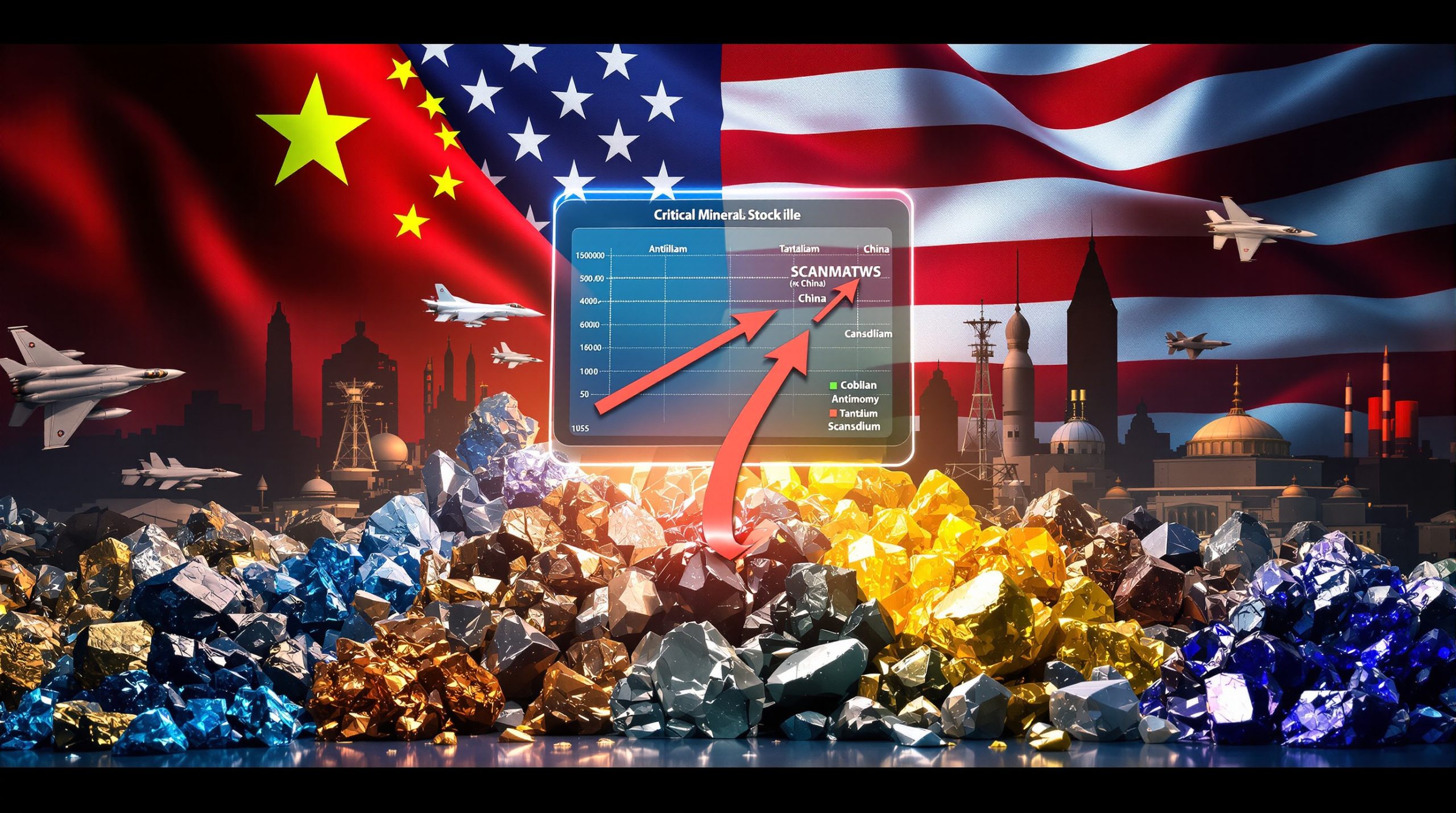US-Australia Rare Earths Collaboration: A Strategic Partnership for Critical Mineral Security
The strategic alliance between the United States and Australia on rare earth elements represents a significant geopolitical response to China's dominance in global supply chains. Both nations recognize the vulnerability of relying on a single source for these critical minerals energy security, which are essential to defense technologies, renewable energy systems, and high-tech manufacturing.
Recent developments have accelerated this partnership, particularly after China implemented additional export restrictions on rare earth products. These actions have heightened concerns about supply chain resilience and national security implications, pushing both countries to formalize collaborative frameworks ensuring stable access to these strategic resources.
What is Driving the US-Australia Rare Earths Partnership?
China's domination of the global rare earth supply chain has created significant vulnerabilities for Western economies. The United States and Australia have recognized that establishing alternative supply routes is no longer just an economic consideration but a matter of national security.
The partnership gained momentum in 2023 when China announced export restrictions on certain rare earth processing technologies and magnet manufacturing expertise. This move followed earlier restrictions on gallium and germanium exports, further highlighting the risks of overdependence on a single supplier.
Both the U.S. Department of Defense and Australian government have identified rare earth elements as strategic critical minerals essential for national security in their respective strategic documents. This shared assessment has provided the foundation for deeper cooperation.
How Does China's Dominance Affect Global Rare Earth Markets?
Current Market Dynamics
China currently controls approximately 70% of global rare earth mine production and 85-90% of global processing and refining capacity. This market concentration has enabled China to leverage its position for geopolitical advantage, particularly during periods of international tension.
The implementation of additional export controls by China has sent ripples through global markets, with prices for key rare earth elements experiencing significant volatility. In 2010, when China imposed export quotas, some rare earth oxide prices increased by over 500%, demonstrating the potential market impact of supply restrictions.
This market instability has reinforced the strategic imperative for alternative supply chains outside Chinese influence, especially as demand for rare earths in clean energy technologies continues to grow.
Strategic Vulnerabilities
The concentration of rare earth processing in a single country creates multiple vulnerabilities:
-
Supply disruption risks during geopolitical conflicts
-
Price manipulation potential by the dominant supplier
-
Technology transfer requirements that compromise intellectual property
-
Reduced innovation in processing technologies outside China
-
Environmental standards disparities creating uneven competition
These vulnerabilities have become increasingly apparent as defense and clean energy sectors grow more dependent on rare earth elements, making diversification a national security priority for both the US and Australia.
Key Components of the US-Australia Rare Earths Agreement
Financial Framework and Investment Strategies
The partnership includes significant financial mechanisms designed to overcome the capital barriers that have historically prevented the development of competitive rare earth processing outside China:
-
Direct government investments in mining and processing infrastructure
-
Risk-sharing mechanisms for private sector participants
-
Preferential financing terms for projects meeting strategic criteria
-
Price floor guarantees to ensure economic viability during market volatility
-
Tax incentives for companies participating in the supply chain
These financial structures build upon previous investments, such as the U.S. Department of Energy's commitment of $140 million for rare earth and battery material processing projects in 2022.
Technology Sharing and Capability Building
A critical aspect of the partnership involves addressing Australia's current limitations in rare earth processing capabilities:
-
Transfer of advanced separation and refining technologies from US partners
-
Joint research initiatives to develop next-generation processing methods
-
Technical training programs to build specialized workforce capabilities
-
Standardization of processing protocols to ensure interoperability
-
Collaborative intellectual property frameworks that protect innovations
This technology-sharing component aims to rapidly close the capability gap that has prevented Australia from moving beyond mining into higher-value processing activities.
Strategic Reserves and Stockpiling Initiatives
To buffer against potential supply disruptions, the agreement includes provisions for:
-
Creation of physical stockpiles of processed rare earth materials
-
Distributed storage locations across both countries
-
Rotation systems to prevent material degradation
-
Trigger mechanisms for release during supply emergencies
-
Coordinated purchasing strategies to prevent market distortion
These stockpiling initiatives represent a significant shift from just-in-time supply chains toward more resilient models that can withstand geopolitical shocks. The approach builds on historical precedents, as the U.S. previously maintained a strategic rare earth reserve through the National Defense Stockpile before materials were sold off in the 1990s and 2000s.
How Will This Partnership Impact Australian Rare Earth Companies?
Market Opportunities for ASX-listed Miners
The US-Australia rare earths collaboration creates substantial new opportunities for Australian rare earth companies, particularly those with advanced projects or existing operations. Companies positioned to benefit include:
-
Arafura Rare Earths, which has seen significant share price appreciation following developments in the partnership
-
Lynas Rare Earths, currently the only significant rare earth producer outside China, operating the Mt Weld mine in Western Australia
-
Other ASX-listed rare earth explorers and producers with NdPr-rich deposits that align with defense and clean energy priorities
-
Companies with potential for rapid scaling of production capabilities
The partnership potentially transforms the economics of Australian rare earth projects by providing guaranteed markets, price stability mechanisms, and access to processing technologies.
Regulatory and Permitting Advantages
The strategic importance attached to rare earth projects under the partnership framework is expected to create regulatory advantages:
-
Streamlined environmental approval processes
-
Priority infrastructure access and development
-
Expedited permitting for projects meeting national interest criteria
-
Coordinated approach to native title and land access issues
-
Harmonized compliance requirements across jurisdictions
These regulatory advantages could significantly reduce the time from discovery to production for qualifying projects, addressing a key competitive disadvantage in the sector.
Investment and Capital Raising Implications
The partnership is already influencing investment patterns in the sector:
-
Increased institutional investor interest in rare earth companies with US market exposure
-
Enhanced ability to secure project financing through government-backed guarantees
-
Potential for premium valuations based on strategic positioning
-
New joint venture opportunities with US technology partners
-
Reduced sovereign risk perception for Australian rare earth assets
This changing investment landscape could help address the historical challenges Australian rare earth companies have faced in securing adequate capital for development. For instance, Lynas Rare Earths received a $30.4 million grant from the Australian government in 2020 for a rare earth processing facility in Western Australia, demonstrating how government support can catalyze project development.
What Processing Technologies Will Be Prioritized?
Critical Separation and Refining Methods
The technology sharing component of the partnership will focus on several key processing capabilities:
-
Solvent extraction systems optimized for Australian rare earth mineralogy
-
Ion exchange technologies for high-purity separation
-
Advanced metallurgical techniques for complex ore bodies
-
Environmentally optimized processing methods with reduced chemical usage
-
Energy-efficient separation technologies to improve economic competitiveness
Solvent extraction remains the dominant technology for rare earth separation, using organic compounds in organic solvents to selectively extract individual rare earth elements. However, this process is complex and requires significant technical expertise—a key barrier to establishing processing capacity outside China.
Environmental and Sustainability Innovations
The partnership emphasizes environmentally responsible processing as a competitive advantage:
-
Closed-loop water recycling systems
-
Reduced acid consumption technologies
-
Waste valorization approaches that create secondary product streams
-
Energy efficiency improvements to reduce carbon footprint
-
Tailings management innovations that minimize environmental impact
Research into more environmentally friendly separation methods includes the use of ionic liquids, which can potentially reduce acid consumption by up to 50%. These sustainability innovations aim to create a "green premium" for Australian-processed rare earths in environmentally conscious markets.
Digital Integration and Automation
To achieve competitive costs despite higher labor rates, the partnership will emphasize:
-
Advanced process control systems
-
AI-optimized separation techniques
-
Robotics for handling hazardous materials
-
Real-time monitoring and quality control systems
-
Digital twin technologies for process optimization
These modern mine planning technology represents a pathway to overcome the cost advantages that have historically favored Chinese processors, where labor costs can be 30-50% lower than in Western operations.
How Does This Collaboration Fit Into Broader Indo-Pacific Strategy?
Security Implications Beyond Rare Earths
The rare earths partnership represents one component of a broader strategic realignment in the Indo-Pacific region:
-
Creation of resilient supply chains for multiple critical minerals
-
Development of northern Australia as a strategic resource corridor
-
Enhanced port and transportation infrastructure with dual civilian-military applications
-
Strengthened economic interdependence between allied nations
-
Reduced vulnerability to economic coercion through diversified supply networks
This broader context highlights how the rare earths collaboration serves multiple strategic objectives beyond the minerals themselves.
Integration with Existing Defense Arrangements
The partnership builds upon and enhances existing defense cooperation:
-
Alignment with AUKUS submarine and technology initiatives announced in September 2021
-
Complementary to Quad Strategic Resources Working Group established in 2021
-
Supporting Five Eyes intelligence sharing on resource security
-
Enhancing interoperability of defense industrial bases
-
Creating secure supply chains for military technology components
This integration ensures that rare earth cooperation supports rather than operates in isolation from broader security frameworks.
Economic Diversification Benefits
Beyond security considerations, the partnership offers economic diversification advantages:
-
Creation of high-value manufacturing opportunities in regional areas
-
Development of specialized technical workforce capabilities
-
Establishment of research centers focused on advanced materials
-
Potential for downstream manufacturing of rare earth-dependent products
-
Export opportunities to allied nations seeking non-Chinese supplies
These economic benefits help build domestic political support for what might otherwise be viewed as purely security-focused investments.
What Challenges Must Be Overcome for Success?
Economic Viability Concerns
Despite the strategic importance, several economic challenges must be addressed:
-
Persistent cost advantages of Chinese processors due to scale and experience, estimated at 30-50% lower than potential Western alternatives
-
High capital requirements for establishing competitive processing facilities, with commercial-scale rare earth separation plants requiring estimated investments of $500 million to $1 billion
-
Fluctuating market prices creating uncertainty for long-term investments
-
Need for sustained government support beyond initial establishment phase
-
Competition from other emerging rare earth producers globally
The partnership must create mechanisms to address these economic fundamentals rather than simply subsidizing uncompetitive operations.
Technical and Workforce Limitations
Australia faces significant technical hurdles in establishing processing capabilities:
-
Limited domestic expertise in rare earth separation and refining
-
Shortage of specialized chemical engineers and metallurgists
-
Need for rapid knowledge transfer from US partners
-
Challenges in adapting technologies to Australian conditions
-
Requirements for specialized analytical capabilities and equipment
The specialized nature of rare earth processing is underscored by the fact that the U.S. Bureau of Labor Statistics does not even track rare earth processing as a specific occupation category, indicating the niche nature of these skills.
Environmental and Community Considerations
Successful implementation must navigate important environmental and social considerations:
-
Stringent environmental standards for processing facilities
-
Community concerns about chemical usage and waste management
-
Native title and indigenous heritage protection requirements
-
Water usage constraints in arid mining regions
-
Transportation and logistics challenges for hazardous materials
Failure to adequately address these considerations could create significant delays and opposition to project development.
What is the Expected Timeline for Implementation?
Near-term Priorities (2024-2026)
The initial phase of the partnership focuses on establishing foundations:
-
Finalization of funding mechanisms and governance structures
-
Identification of priority projects for immediate support
-
Initial technology transfer agreements between key partners
-
Commencement of feasibility studies for processing facilities
-
Development of workforce training programs
These near-term priorities aim to create momentum and demonstrate commitment from both governments.
Medium-term Developments (2027-2029)
The middle phase will focus on building physical infrastructure:
-
Construction of initial processing facilities
-
Establishment of pilot plants for technology demonstration
-
Development of specialized logistics networks
-
Creation of initial strategic stockpiles
-
Expansion of mining operations to feed processing capacity
This phase represents the most capital-intensive period and will require sustained political support through potential changes in government.
Long-term Vision (2030 and beyond)
The mature phase of the partnership envisions:
-
Fully integrated mine-to-manufacturer supply chains
-
Competitive processing capabilities at global scale
-
Innovation leadership in separation technologies
-
Expanded downstream manufacturing utilizing rare earth products
-
Resilient supply networks capable of withstanding disruptions
This timeline is realistic based on historical development patterns. Lynas Rare Earths, for example, took approximately 15 years from discovery of the Mt Weld deposit to commercial production, highlighting the extended timeframes required for rare earth project development.
How Can Investors Position for This Strategic Shift?
Key Investment Opportunities
The US-Australia rare earths partnership creates several investment themes:
-
ASX-listed rare earth explorers and producers with advanced projects
-
Companies with existing relationships with US defense contractors
-
Businesses developing innovative processing technologies
-
Service providers specializing in rare earth project development
-
Equipment manufacturers supporting processing infrastructure
Investors should evaluate companies based on their alignment with partnership priorities and ability to execute within the new framework.
Risk Factors to Consider
Despite the strategic tailwinds, several risks remain:
-
Potential policy changes following election cycles
-
Technical challenges in scaling new processing technologies
-
Competition from other international partnerships
-
Market price volatility despite stabilization mechanisms
-
Execution risks in complex project development
A diversified approach to the sector may help mitigate these specific risks while maintaining exposure to the broader thematic.
Long-term Strategic Positioning
Beyond tactical investment opportunities, the partnership signals important long-term shifts:
-
Increasing government intervention in critical raw materials facility markets
-
Premium valuations for projects with geopolitical significance
-
Growing importance of environmental and social governance factors
-
Advantage to companies with strong government relationships
-
Value of intellectual property in processing technologies
These structural shifts suggest that traditional evaluation metrics may need adjustment when assessing companies in this sector.
FAQ: US-Australia Rare Earths Collaboration
What specific rare earth elements are prioritized in this partnership?
The collaboration prioritizes heavy rare earth elements with strategic applications, particularly dysprosium and terbium, and the light rare earths neodymium and praseodymium (NdPr). These elements are critical minerals for semiconductors and permanent magnets used in defense systems, electric vehicles, and wind turbines. The partnership's focus reflects both current supply vulnerabilities and projected demand growth in these specific elements.
How does this partnership affect existing Chinese investments in Australian rare earth projects?
The partnership introduces new scrutiny for Chinese investments in Australian rare earth assets. While existing investments aren't directly affected, new foreign investment proposals from Chinese entities in this sector will likely face enhanced national security reviews. The partnership also creates competitive pressures for Chinese-affiliated projects, as preferential treatment may be given to fully Australian or US-Australian ventures.
Will this collaboration extend to other critical minerals beyond rare earths?
Yes, while rare earths form the initial focus, the partnership establishes frameworks that can extend to other critical minerals including lithium, cobalt, graphite, and manganese. The governance structures being created are designed with flexibility to incorporate additional minerals as strategic priorities evolve, creating a comprehensive approach to critical mineral security.
How does this partnership address environmental concerns in rare earth processing?
Environmental sustainability forms a core component of the collaboration, with specific provisions for developing and implementing cleaner processing technologies. The partnership explicitly aims to establish environmental leadership as a competitive advantage, investing in closed-loop systems, reduced chemical usage, and improved waste management protocols that exceed current industry standards.
What role will private sector companies play in implementation?
Private sector participation is central to the partnership's success. The government framework creates enabling conditions through financial incentives, risk-sharing mechanisms, and market guarantees, but execution relies on commercial entities. The partnership establishes public-private coordination bodies to ensure alignment between government objectives and commercial realities throughout implementation.
Conclusion: A Transformative Opportunity with Significant Challenges
The US-Australia rare earths collaboration represents a significant strategic shift in how Western nations approach critical mineral security. By combining Australia's substantial resource base with American technological capabilities and market demand, the collaboration creates a foundation for breaking China's dominance in the rare earth supply chain.
The success of this initiative will depend on addressing fundamental challenges in economics, technology, and environmental management. If these challenges can be overcome, the partnership has the potential to reshape global rare earth markets while strengthening broader Indo-Pacific security arrangements.
For investors, this evolving landscape creates both opportunities and risks. Those who can accurately assess which companies are best positioned to benefit from the partnership—while realistically evaluating the technical and execution challenges—may find significant long-term value in this strategic sector.
Disclaimer: This article contains forward-looking statements about geopolitical developments, market trends, and investment opportunities. These statements involve risks and uncertainties, and actual outcomes may differ substantially from what is described. Readers should conduct their own due diligence before making investment decisions based on the information provided.
Ready to Spot the Next Major Mineral Discovery?
Stay ahead of the market with Discovery Alert's proprietary Discovery IQ model, delivering instant notifications on significant ASX mineral discoveries as they happen. Explore how historic discoveries have generated substantial returns by visiting our dedicated discoveries page and begin your 30-day free trial today.




